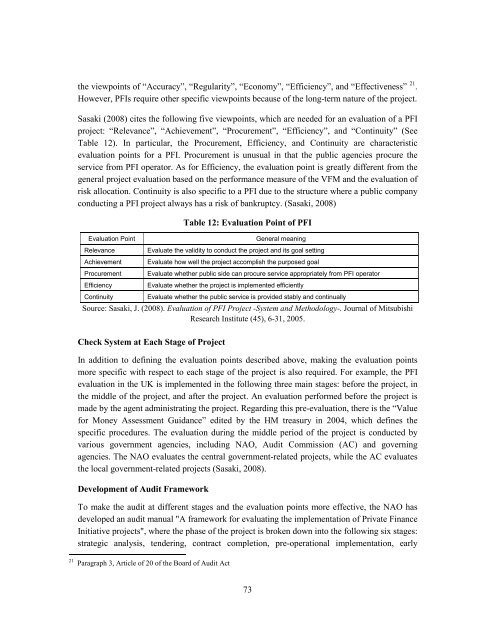Risk Management and Governance for PFI Project ... - Title Page - MIT
Risk Management and Governance for PFI Project ... - Title Page - MIT
Risk Management and Governance for PFI Project ... - Title Page - MIT
You also want an ePaper? Increase the reach of your titles
YUMPU automatically turns print PDFs into web optimized ePapers that Google loves.
the viewpoints of “Accuracy”, “Regularity”, “Economy”, “Efficiency”, <strong>and</strong> “Effectiveness” 21 .<br />
However, <strong>PFI</strong>s require other specific viewpoints because of the long-term nature of the project.<br />
Sasaki (2008) cites the following five viewpoints, which are needed <strong>for</strong> an evaluation of a <strong>PFI</strong><br />
project: “Relevance”, “Achievement”, “Procurement”, “Efficiency”, <strong>and</strong> “Continuity” (See<br />
Table 12). In particular, the Procurement, Efficiency, <strong>and</strong> Continuity are characteristic<br />
evaluation points <strong>for</strong> a <strong>PFI</strong>. Procurement is unusual in that the public agencies procure the<br />
service from <strong>PFI</strong> operator. As <strong>for</strong> Efficiency, the evaluation point is greatly different from the<br />
general project evaluation based on the per<strong>for</strong>mance measure of the VFM <strong>and</strong> the evaluation of<br />
risk allocation. Continuity is also specific to a <strong>PFI</strong> due to the structure where a public company<br />
conducting a <strong>PFI</strong> project always has a risk of bankruptcy. (Sasaki, 2008)<br />
Table 12: Evaluation Point of <strong>PFI</strong><br />
Evaluation Point General meaning<br />
Relevance Evaluate the validity to conduct the project <strong>and</strong> its goal setting<br />
Achievement Evaluate how well the project accomplish the purposed goal<br />
Procurement Evaluate whether public side can procure service appropriately from <strong>PFI</strong> operator<br />
Efficiency Evaluate whether the project is implemented efficiently<br />
Continuity Evaluate whether the public service is provided stably <strong>and</strong> continually<br />
Source: Sasaki, J. (2008). Evaluation of <strong>PFI</strong> <strong>Project</strong> -System <strong>and</strong> Methodology-. Journal of Mitsubishi<br />
Research Institute (45), 6-31, 2005.<br />
Check System at Each Stage of <strong>Project</strong><br />
In addition to defining the evaluation points described above, making the evaluation points<br />
more specific with respect to each stage of the project is also required. For example, the <strong>PFI</strong><br />
evaluation in the UK is implemented in the following three main stages: be<strong>for</strong>e the project, in<br />
the middle of the project, <strong>and</strong> after the project. An evaluation per<strong>for</strong>med be<strong>for</strong>e the project is<br />
made by the agent administrating the project. Regarding this pre-evaluation, there is the “Value<br />
<strong>for</strong> Money Assessment Guidance” edited by the HM treasury in 2004, which defines the<br />
specific procedures. The evaluation during the middle period of the project is conducted by<br />
various government agencies, including NAO, Audit Commission (AC) <strong>and</strong> governing<br />
agencies. The NAO evaluates the central government-related projects, while the AC evaluates<br />
the local government-related projects (Sasaki, 2008).<br />
Development of Audit Framework<br />
To make the audit at different stages <strong>and</strong> the evaluation points more effective, the NAO has<br />
developed an audit manual "A framework <strong>for</strong> evaluating the implementation of Private Finance<br />
Initiative projects", where the phase of the project is broken down into the following six stages:<br />
strategic analysis, tendering, contract completion, pre-operational implementation, early<br />
21 Paragraph 3, Article of 20 of the Board of Audit Act<br />
73

















